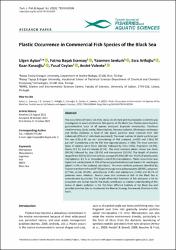Plastic occurrence in commercial fish species of the Black Sea

View/
Access
info:eu-repo/semantics/openAccessDate
2022Author
Aytan, ÜlgenEsensoy, Fatma Başak
Şentürk, Yasemen
Arifoğlu, Esra
Karaoğlu, Kaan
Ceylan, Yusuf
Valente, Andre
Metadata
Show full item recordCitation
Aytan, U., Esensoy, F.B., Senturk, Y., Arifoğlu, E., Karaoğlu, K., Ceylan, Y., & Valente, A. (2022). Plastic Occurrence in Commercial Fish Species of the Black Sea. Turkish Journal of Fisheries and Aquatic Sciences, 22(7), TRJFAS20504. http://doi.org/10.4194/TRJFAS20504Abstract
The occurrence of micro- ( 5 mm), meso- (5-25 mm) and macroplastics ( 25mm) was investigated in seven commercial fish species of the Black Sea. Plastics were found in gastrointestinal track of all species analysed: Engraulis encrasicolus, Trachurus mediterraneus, Sarda sarda, Belone belone, Pomatus saltatrix, Merlangius merlangus and Mullus barbatus. A total of 352 plastic particles were removed from 190 individuals (29% of all individuals examined). The mean number of plastic particles per fish was 0.81 +/- 1.42 par.ind-1 (considering all fish analysed, n=650) and 2.06 +/- 1.09 par.ind-1 (considering only the fish that ingested plastic, n=190). The most common types of plastics were fibres (68.5%), followed by films (19%), fragments (11.9%), foams (0.3 %) and microbeads (0.3%). The most common plastic colour was black (39.3%) followed by blue (19.5%) and transparent (18.1%). The length of plastics ranged from 0.05 to 26.5 mm with an average of 1.84 +/- 2.80 mm. 93.2% of plastics were microplastics, 6.5 % as mesoplastics and 0.3% macroplastics. Plastic occurrence was higher in S. sarda (plastic in 70% of the analysed individuals) and lower in M. merlangus (plastic in 9% of the analysed individuals). The main synthetic polymers identified by Fourier-transform infrared (FTIR) spectroscopy were polypropylene (29.8%), polyester (17.5%), acrylic (15.8%), polyethylene (14%) and polystyrene (1.8%) and 21.1% of polymers were cellulosic. Results show that commercial fish of the Black Sea is contaminated by plastics. This might affect vital functions of fish and pose a risk to ecosystem and human health. The study contributes to a better understanding of the status of plastic pollution in the fish from different habitats of the Black Sea and provides baseline data to implement the Marine Strategy Framework Directive in the basin.

















